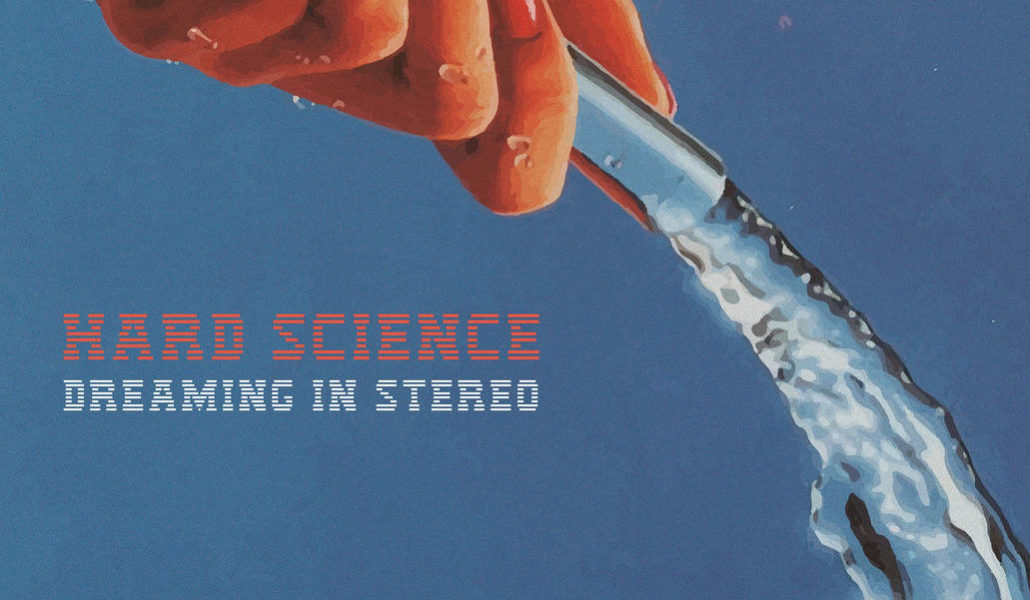New Music: Hard Science – Dreaming in Stereo

Those who have been to shows in Ottawa long enough are probably familiar with the name Hard Science. However, chances are you didn’t know that the name associated was associated with music. Arturo Brisindi, a.k.a. Hard Science is an artist who has become known for his work with modular analog and video synthesizers over the years. His visual creations often take the form of projected video on walls, ceilings, and stages, and create breathtaking visual landscapes for us to bask in. While this is a world that I am admittedly not particularly familiar with, I have seen his work at events and can attest to its ability to transform a room. Those of us who grew up in the 80’s and 90’s probably experience some nostalgia when watching his visualizations – I’m talking Windows ’95 era stuff. He has also created a video for a song on the soundtrack for the critically-acclaimed music documentary, I Dream of Wires featured on Netflix.
Hard Science has more up his sleeve. He is set to release his debut LP Dreaming in Stereo on Thursday, June 15, at Bar Robo. The album is a collection of tracks that have been produced from 2008-2016, a project that spans the better part of a decade. Dreaming in Stereo balances catchy synth pop with some experimentation, as Brisindi takes us on a sonic tour of his imagination. As we wander through the knobs and wiring in his brain, we find more than just drum machine loops and synthesizer effects. Hard Science draws us in through “pop,” but exposes the listener to a range of sounds produced from vintage equipment. These layers are also infused with interesting vocal samples and divergent arrangements, ultimately making it an album that is accessible enough for average listeners unfamiliar with this kind of production, but also complex enough for the hardcore gear and sound connoisseurs.
I had a chat with Hard Science about the new album, have a read and listen below.
Hard Science will be releasing the album at Bar Robo on June 15, doors at 8pm. Dreaming in Stereo will be available in vinyl at the event, as well as online through Analog Kitchun Records and streaming on Bandcamp.
Interview with Hard Science
Can you explain briefly how this album came to be?
The album really flowed from my vintage synth collection and all the exploring that I did as it grew (I guess you could call it gear-driven?). It all started back in early 2009 when I scored a Roland Juno 60 and a Roland Jupiter 4, along with 707, 909 and 808 drum machines. Throughout the years, I acquired more and more of these classic vintage synths, drum machines and tape echoes. With every acquisition came a new song. With every song came the urge to get more synths. Synths are sort of like chips; you can’t have just one.
Starting around 2012, I got into video and took a bit of a break from working on the album and music in general. Most of the groundwork for the album was done, with the exception of vocals and non-synth instruments. These parts came together between 2013 and 2015 with the help of Caleb Abbott and Olexandra Pruchnicky (vocals), along with Jason Redmond (bass), and Jose Palacios (guitar).
Unsure of what to do, and doubting that people would even like it (what would any self respecting artist be without crippling self doubt?), I put it on the back burner for a few more years. It wasn’t until this past winter that I decided to release the album, with a little push from my friends Grant Young, who released the vinyl edition on his label Analogkitchun Records, and Max Harwood, who offered to design my album cover out of the blue! I can honestly say that without Grant and Max, this album would still be sitting on my hard drive. So here we are, 9 years after recording the first song, and the album is finally out there.
What do the worlds of analog video and synth music have in common?
Quite a bit actually. Video synthesis uses some of the same fundamental building blocks as audio synthesis. It’s not uncommon, specifically in the modular video world, to see oscillators, mixers, modulation sources like LFOs and envelopes, VCAs, and filters. The main difference between audio and video is the frequency range. Audio is limited to 20Hz to 20,000Hz, whereas video signals can go up into the megahertz! Overall though, the methods used in modular video synthesis are almost identical to those of audio subtractive synthesis.
Can you talk about the synth scene in Ottawa?
The Ottawa synth scene is starting to hit its stride. With things like the Switched on Synths series and SOSFest at House of Targ this weekend, Possible Worlds’ Producer Meet-up Series, Not Normal, National Drone Day, synth meets, plus a bunch of other events popping up here and there, we’re starting to see a lot more engagement and comradery. With the Ottawa Synths Facebook group, people from all over Ottawa/Gatineau have a place to mingle, talk shop and sell their wares. I’m seeing collaborations between members and friendships forming. It’s a beautiful thing.
What can newcomers to this kind of music/performance expect from the album release?
I’m a fan of pop music, so I try to make music that’s catchy and accessible. But at the same time, I’m a stickler for tone and atmosphere, so I try my best to add a very specific character to my songs. A lot my songs have that eighties feel to them. Nostalgia is a huge factor for me. I’m a child of the eighties, and there’s just something about that wobbly, drenched-in-delay synth sound that grabs me like nothing else. That and a heavy dose of gated reverb on the snare.
For the album listening party at Bar Robo (June 15th), we’ll just be putting Dreaming In Stereo on the loudspeakers for all to enjoy. It’ll be pretty laid back. For my SOSFest set at Targ (June 16th), I’ll be performing a whole new set of songs that aren’t on Dreaming In Stereo, but are still a similar style.
